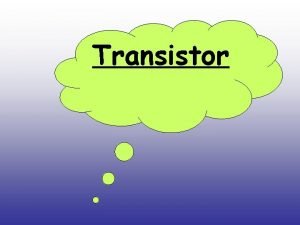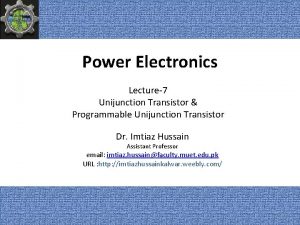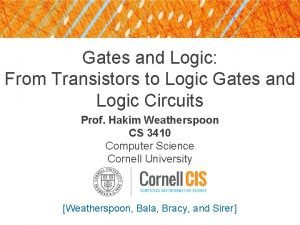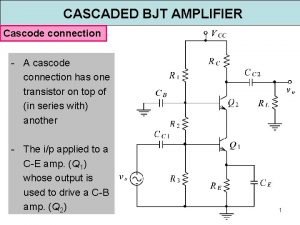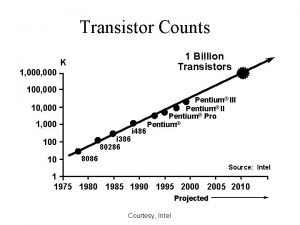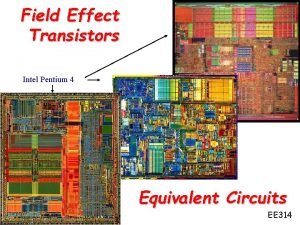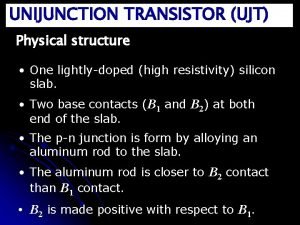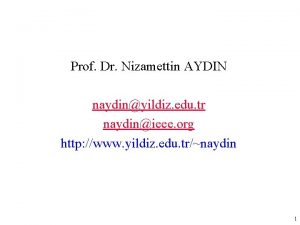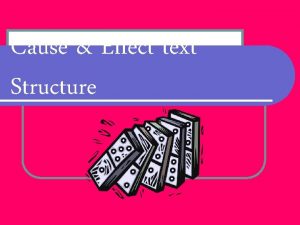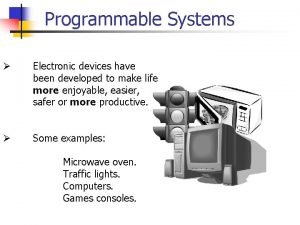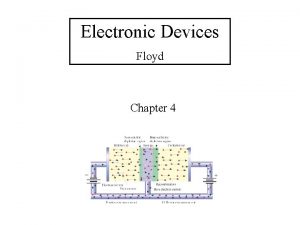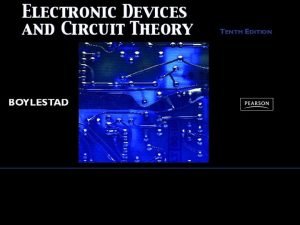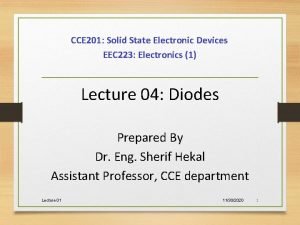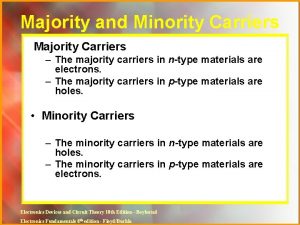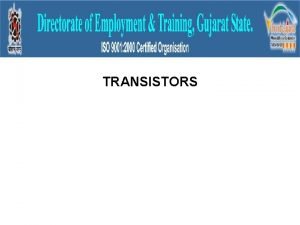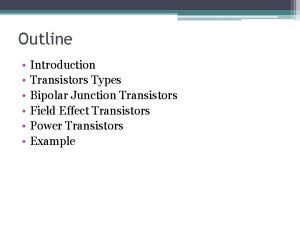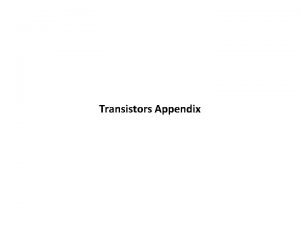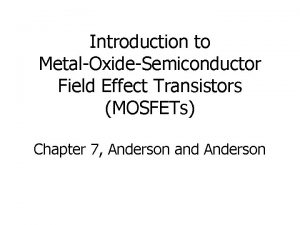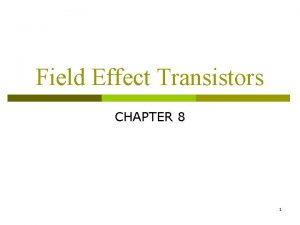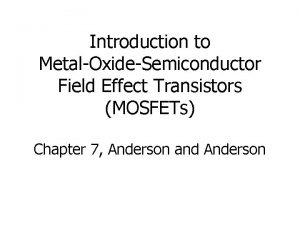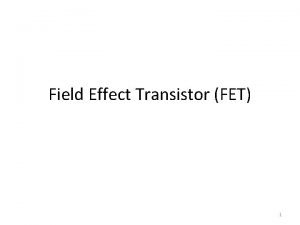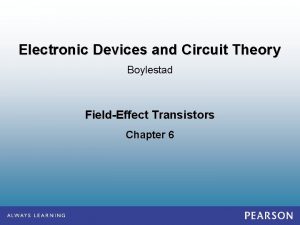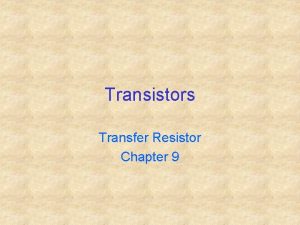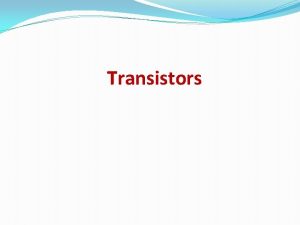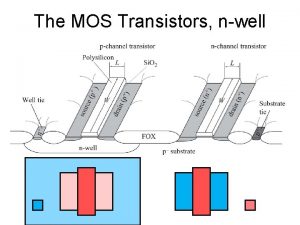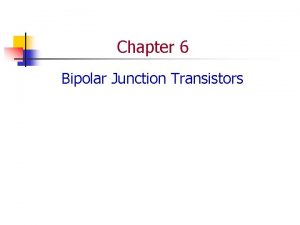SEE 2063 Electronic Devices Introduction Field effect transistors



















- Slides: 19

SEE 2063 Electronic Devices

Introduction • Field effect transistors are unipolar devices that control current by voltage applied to the gate. • Two main types of FETs are JFET and MOSFET • The FET’s major advantage over the BJT is high input resistance. • Overall, the purpose of the FET is the same as that of the BJT. 2

JFET Basic Structure • A JFET can be either p channel or n channel. • Two p-type regions are diffused in the n-type material to form a channel • The terminals of a JFET are the source, gate, and drain. 12/22/2021 3

JFET Basic Operation • JFET is always operated with the gate-source pn junction reverse biased • VGG sets the reverse-bias voltage between the Gate and the Source • VDD provides a VDS and supplies current from Drain to Source 12/22/2021 4

Basic Operation • JFET operates with a reverse-biased pn junction to control current in a channel • Reverse biasing of the Gate-Source junction with a negative VG produces a depletion region along the pn junction, which extends into the n channel and thus increases its resistance by restricting the channel width 12/22/2021 5

The channel width and thus the channel resistance can be controlled by varying the gate voltage 6 12/22/2021 6

JFET schematic symbols 7 Copyright © 2005 by Pearson Education, Inc. Upper Saddle River, New Jersey 07458 All rights reserved. 7

BJT vs FET • Bipolar Device Both electrons and holes act as carriers • Two types NPN & PNP • Current-controlled device IB controls the amount of IC 12/22/2021 • Unipolar Device Operates only with one type of charge carrier • Two main types JFET & MOSFET • Voltage-controlled device VGS controls the current through the device 8 8

SUMMARY • FETs are unipolar devices (one-charge carrier) • The three FET terminals are source, drain, and gate • The JFET operates with a reverse-biased pn junction (gate -to-source) • The high input resistance of a JFET is due to reversebiased gate-source junction • Reverse bias of a JFET produces a depletion region within the channel, thus increasing channel resistance 12/22/2021 9

Effect of VDS on ID 12/22/2021 10

Drain Characteristics (VGS = 0 V) • For a small value of VDS, JFET behaves as a simple resistor between the D and the S. • As VDS increases from 0 V, ID increases in an approximately linear manner (ohm’s law) • As VDS continue to increase, noticeable depletion regions begin to form in the channel • Depletion regions are broader near the drain end of the channel • Total resistance of the channel is increased • The rise in current is no longer proportional to VDS • The current begins to level off 11

…. Drain Characteristics (VGS = 0 V) • As VDS increases to a value known as the pinch-off voltage (Vp), the depletion region increases to the point where the conducting channel at the drain end is completely pinch-off • The current reaches a maximum value (IDSS) at pinch-off and that it continues to flow at that value as VDS is increased beyond Vp • Breakdown occurs at large values of VDS and is caused by the avalanche mechanism • At breakdown, ID begins to increase very rapidly with any further increase in VDs • Breakdown can result in irreversible damage to the device 12/22/2021 12

Drain Characteristics of an n-channel JFET 13

Drain Characteristics of an n-channel JFET • VGS controls ID • ID decreases as the magnitude of VGS increases • For each increase in VGS, JFET reaches pinch-off at values of VDS less than Vp • Breakdown occurs at the smaller value of VDS as the magnitude of VGS increases 12/22/2021 14

JFET at Cutoff The cutoff voltage, VGS(off), is the value of VGS that makes ID = 0 A 15

JFET Transfer Characteristics • JFET must operate between VGS = 0 V and VGS(off) • For this range of VGS, 0 IDSS 16 16

Construction of transfer characteristic from the drain characteristics VGS(off) and Vp are always equal in magnitude but opposite in sign 12/22/2021 17

JFET Parameters • • • Ohmic Area (Voltage-Controlled Resistance Region) An area where VDS and ID are related by Ohm’s Law Pinch-Off Voltage, Vp The value of VDS at which ID becomes constant when VGS = 0 V IDSS The Drain to Source current with the gate Shorted (VGS = 0 V) Constant-Current Area (Pinch-Off Region, Active Region, Saturation Region ) The region in which the JFET is normally operated when used for small-signal amplification Cut-Off Voltage The value of VGS at which ID becomes zero 12/22/2021 18

SUMMARY • Gate-Source junction must be reverse-biased • VGS controls ID • Transfer characteristic: • JFET is normally ON. When the gate voltage is 0 V, the drain current is maximum and is IDSS 12/22/2021 19
 Agenda 2063
Agenda 2063 Electronic field production examples
Electronic field production examples How transistors work
How transistors work Put ujt
Put ujt Application des transistors bipolaires
Application des transistors bipolaires Logic gates truth tables
Logic gates truth tables Cascade connection
Cascade connection 1 billion transistors
1 billion transistors Graphical analysis
Graphical analysis Ujt structure
Ujt structure Kilo mega giga tera peta
Kilo mega giga tera peta Transistors were used in which generation of computers
Transistors were used in which generation of computers Today nanotechnology produced computer transistors
Today nanotechnology produced computer transistors Scrip exchange
Scrip exchange Cause and effect text structure paragraph
Cause and effect text structure paragraph Programmable electronic devices
Programmable electronic devices Electronic devices floyd 10th edition
Electronic devices floyd 10th edition High frequency model of bjt
High frequency model of bjt Solid state electronic devices 7th solution chapter 4
Solid state electronic devices 7th solution chapter 4 Difference between majority and minority carriers
Difference between majority and minority carriers


